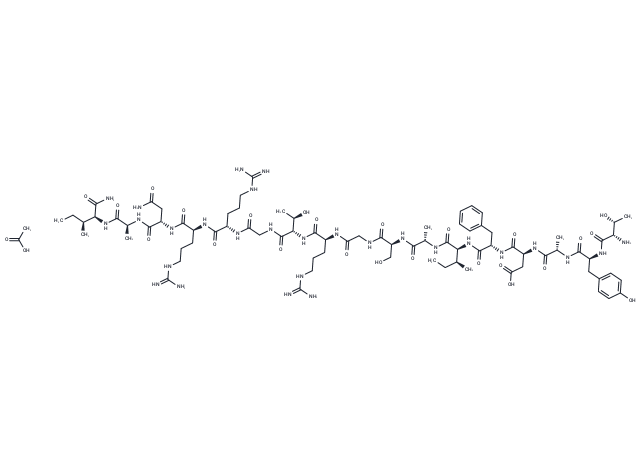Shopping Cart
- Remove All
 Your shopping cart is currently empty
Your shopping cart is currently empty

PKA inhibitor fragment (6-22) amide Acetate is a synthetic peptide which selectively inhibits PKA activity by binding to its substrate site (IC50 < 2 nM).

| Pack Size | Price | Availability | Quantity |
|---|---|---|---|
| 1 mg | $87 | In Stock | |
| 2 mg | $125 | In Stock | |
| 5 mg | $178 | In Stock | |
| 10 mg | $293 | In Stock | |
| 25 mg | $491 | In Stock | |
| 50 mg | $716 | In Stock | |
| 100 mg | $987 | In Stock | |
| 1 mL x 10 mM (in DMSO) | $481 | In Stock |
| Description | PKA inhibitor fragment (6-22) amide Acetate is a synthetic peptide which selectively inhibits PKA activity by binding to its substrate site (IC50 < 2 nM). |
| Targets&IC50 | PKA:2.8 nM(ki) |
| Alias | PKA inhibitor fragment (6-22) amide Acetate(121932-06-7 Free base) |
| Molecular Weight | 1928.11 |
| Formula | C82H134N28O26 |
| Smiles | CC(O)=O.CC[C@H](C)[C@@H](C(N)=O)NC([C@H](C)NC([C@H](CC(N)=O)NC([C@H](CCCNC(N)=N)NC([C@H](CCCNC(N)=N)NC(CNC([C@H]([C@H](O)C)NC([C@H](CCCNC(N)=N)NC(CNC([C@H](CO)NC([C@H](C)NC([C@H]([C@@H](C)CC)NC([C@H](CC1=CC=CC=C1)NC([C@H](CC(O)=O)NC([C@H](C)NC([C@H](CC2=CC=C(O)C=C2)NC([C@H]([C@H](O)C)N)=O)=O)=O)=O)=O)=O)=O)=O)=O)=O)=O)=O)=O)=O)=O)=O |
| Relative Density. | no data available |
| Storage | keep away from moisture | Powder: -20°C for 3 years | In solvent: -80°C for 1 year | Shipping with blue ice. | |||||||||||||||||||||||||
| Solubility Information | DMSO: 55 mg/mL (28.53 mM), Sonication is recommended. | |||||||||||||||||||||||||
Solution Preparation Table | ||||||||||||||||||||||||||
DMSO
| ||||||||||||||||||||||||||

Copyright © 2015-2025 TargetMol Chemicals Inc. All Rights Reserved.